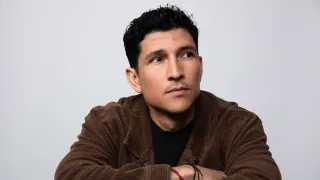March 21, 2023
'The Whale' and the Cinematic Curse of Disabled Queerness
Victoria A. Brownworth READ TIME: 8 MIN.
Brendan Fraser is a good actor, possibly even a great actor. But when he won the Best Actor Oscar at the 95th Academy Awards, count me among those not cheering. I didn't need yet another depiction of a tragic disabled person who would rather be dead than disabled and whose gayness is yet another trope for misery.
When Fraser won, he gave a riveting acceptance speech about how the ease and breadth of youthful opportunity can give way to the bleakness of phones no longer ringing in the paunchy, balding paucity of middle age.
Fraser's performance in "The Whale" was heralded as emotionally riveting and deeply compelling. But for many queer and disabled (and queer disabled) viewers, it was yet another example of the villainizing of disabled and fat people on screen. It was also, yet again, a straight actor winning an Oscar for playing a dying gay person, exactly 30 years after Tom Hanks won the Oscar for playing Andy Beckett, a gay man dying of AIDS in "Philadelphia."
A longtime film aficionado, instructor, and critic, I wrote an essay a decade ago for the Lambda Literary Review titled "How the Movies Taught Me to Love Women Without Killing Myself."
I learned about the dead lesbian trope as a teenager, watching Shirley MacLaine hang herself late one night on TV in an airing of "The Children's Hour." That film of the Lillian Hellman play both introduced me to lesbians on screen and shaped – or perhaps warped – my teenage lesbian life. So too did seeing a repertory screening of Sandy Dennis, a real life lesbian, and Anne Heywood in the film version of D.H. Lawrence's novella "The Fox." Dennis's character is felled by a tree, so her sexually frustrated butch partner, Heywood, can return to wearing dresses and be with a man.
Both films were nominated for Oscars and other awards, with MacLaine and Heywood winning acting awards for their portrayals of unhappy lesbians. "The Fox" was the fifth most popular film in Britain in 1968.
Stigmatizing
The history of how Hollywood handles disability and queerness and their intersection is as fraught as it is disturbing and outraging. That history melds the terrible treatment by the studios of gay and bisexual notables with the stigmatizing of disabled people.
With only a handful of exceptions, disability only wins awards when it's presented by non-disabled directors and actors. It's still shocking that, in 2021, the Academy thought there was more humanity in an octopus than in the story of the groundbreaking disability rights movement in America.
The Oscar for Best Documentary Feature went to "My Octopus Teacher" instead of the extraordinary story of a major civil rights movement impacting America's 63 million disabled people, "Crip Camp: A Disability Revolution." (Bay Area Reporter)
Hollywood's dark history of hiding gay and lesbian actors with sham marriages and fake news stories about heterosexual liaisons slams up against the equally long history of having straight actors play gay roles and non-disabled people play disabled. That actors are nominated for and/or win Oscars for playing gay or playing disabled is almost always a given.
Some actors have built their careers on playing dying or murdered LGTBQ people who are also sometimes disabled. Just as Fraser won the Best Actor Oscar for playing a dying disabled gay man, Jared Leto won Best Supporting Actor in 2014 playing a dying trans woman and Matthew McConaughey won Best Actor that same year for the same film, "Dallas Buyers Club," for his role as a straight man with AIDS.
Oscar Roles
Hilary Swank won the Best Actress Oscar in 1999 for playing murdered trans man Brandon Teena in "Boys Don't Cry," and in 2005 won Best Actress again for playing disabled in "Million Dollar Baby." Charlize Theron played mentally ill lesbian serial killer Aileen Wuornos in 2004 and won the Best Actress Oscar for making the complicated and deeply damaged Wuornos, about whom I reported extensively, a deranged and despicable terrorist in "Monster."
In 2005 Sean Penn won Best Actor for playing the murdered Harvey Milk in "Milk." Eddie Redmayne was nominated for two Best Actor Oscars back to back in 2015 and 2016. He played disabled physicist Stephen Hawking in "The Theory of Everything" and trans woman Lili Elbe in "The Danish Girl." He won for his portrayal of Hawking.
At this year's Oscars, several nominees were straight actors playing gay. In addition to Fraser, Cate Blanchett was nominated as Best Actress for her role as narcissistic lesbian conductor Lydia Tár. (In 2016 Blanchett was nominated for playing the eponymous lesbian role in "Carol.") Stephanie Hsu was nominated for Best Supporting Actress for "Everything Everywhere All At Once," in which she plays lesbian Joy Wang and also Jobu Tupaki, who is homicidal.
Thus far, only three disabled actors have won Oscars: Harold Russell, an amputee and veteran of World War II won Best Supporting Actor in 1947 for "The Best Years of Our Lives," Deaf actor Marlee Matlin won Best Actress in 1987 for "Children of a Lesser God," and Deaf actor Troy Kotsur won Best Supporting Actor in 2022 for "CODA" (Matlin co-stars in that film). So, every 30 to 40 years a disabled actor gets to play disabled and win.
Yet, many non-disabled actors have won Oscars for playing disabled, and the list is shockingly long at nearly 70 nominations and 27 wins. In addition to Hanks, who also won again for playing the disabled "Forest Gump," there are a plethora of Hollywood elites who have won for their portrayals of disability, among them Jack Nicholson, Daniel Day-Lewis, Al Pacino, Dustin Hoffman, Jamie Foxx, Anthony Hopkins, Colin Firth, Jon Voight, Cliff Robertson, Geoffrey Rush, Angelina Jolie, Nicole Kidman, Julianne Moore (she's also been nominated for playing gay), Joanne Woodward, Holly Hunter, Patty Duke, and Jane Wyman.
The same questions are raised continually: Why don't directors cast disabled people in disabled roles or cast LGBTQ people in LGBTQ roles? How much does the lack of true representation influence how these roles are portrayed on screen and who chooses to bring them to the screen at all? Why is the disabled villain a trope and the disabled gay villain, like "The Whale's" Charlie, a villain by virtue solely of being one or the other or both?
Daniel Aronofsky, who directed "The Whale," has made a career of portraying disabled and gay people as monstrous and winning awards for it. In addition to "The Whale," Natalie Portman won the Best Actress Oscar for her portrayal of a psycho lesbian ballerina, Nina, in Aronofsky's "Black Swan." Ellen Burstyn was nominated for Best Actress for "Requiem for a Dream" where she also loses her mind. Samuel D. Hunter, who wrote "The Whale," said, "By the end, Charlie becomes an unlikely vehicle for the audience's empathy."
Why? Because he's fat? Disabled? Gay? All of those? It's certainly true that the viewer is told repeatedly by the direction that Fraser's Charlie is repulsive. But why? Why can't he ever open the curtains? Why can't Charlie get cleaned up and go outside? Why is a disabled man left to simmer in his own filth for over two hours of screen time?
How is adding another gay disabled monster to the film canon a good thing? Why are we made to be repulsed by Charlie, and why was such a depiction lauded by the Academy?
The Academy has been inching toward inclusion of women and people of color in recent years, but with no women directors nominated, and no Black actors in either lead acting category in 2023, that speed is glacial. The addition of queerness and disability into the Hollywood canon as anything but vehicles for non-LGBTQ and non-disabled actors may be much further down that path of inclusion.
Lauding "The Whale" as anything but a vicious and stigmatizing portrayal of the intersection of disability and queerness would be an error, and yet another setback for marginalized people who deserve their own true-to-life stories.
Help keep the Bay Area Reporter going in these tough times. To support local, independent, LGBTQ journalism, consider becoming a BAR member.






